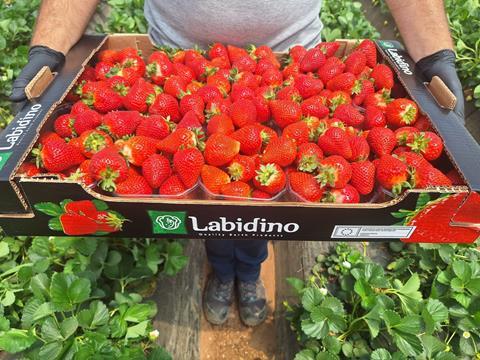Greek strawberry producers have faced significant challenges this past season, including unfavourable weather conditions, labour availability issues and high costs, but Labidino eyes expansion in 2025/26

The Greek strawberry campaign this season began about two weeks later than usual, in the month of November, primarily due to delays to plantings, according to Alexandros Polydoropoulos, agronomist at Greek strawberry specialist Labidino.
“After the plants were established, the weather and especially the prolonged cloudy conditions in my opinion, adversely affected plant growth,” he says. “As a result, production during the first part of the season was reduced by approximately 25 per cent.”
Despite this early setback, demand remained strong, he says. “Prices after February were higher compared to last season,” he reveals. “Fortunately, production recovered in April and May, and the season is expected to conclude with an overall yield about 10 per cent lower than last year. In terms of fruit quality, the crop generally surpassed that of competing producers from other countries, with only minor issues in specific varieties.”
Germany remains the key market for Greek strawberries, serving also as a gateway to neighbouring countries such as the Czech Republic and Austria, according to Polydoropoulos. “Additionally, demand from Balkan and eastern European countries, such as Serbia, Bulgaria, Romania, Poland, Belarus and Moldova, has been steadily increasing,” he adds. “This has helped to keep demand up through the latter part of the season.”
During the 2025 campaign, producers faced significant challenges, including a 20-25 per cent drop in yields during the early part of the season, he reveals. As a result, many companies struggled to meet demand.
“Labour shortages were observed during the peak season due to some workers shifting from the agricultural sector to tourism-related jobs,” he continues. “Over the past five years, the Greek state has established bilateral agreements with countries like Egypt and India, allowing growers to recruit seasonal labour from these nations.”
Increased production costs, due to rising prices for materials and transportation, have added further pressure, Polydoropoulos says. “Although early-season demand was strong, competition from Egyptian imports in Europe kept prices at levels similar to last year,” he adds.
Nevertheless, for the next strawberry season, Greek producers plan to increase cultivated acreage by approximately 10 per cent, he reveals, with aims for expansion into new international markets.
New technologies and automation are gradually being adopted, he says, especially in post-harvest processes such as sorting and packaging. Meanwhile, efforts to boost sustainability are increasing.
“In terms of sustainability, producers are focusing on smart irrigation systems to optimise water use, installing solar panels to power packing facilities, using eco-friendly packaging wherever possible, and reducing pesticide use through natural predators and green products with zero chemical residues,” he says. “These initiatives aim to improve efficiency and minimise environmental impact.”



